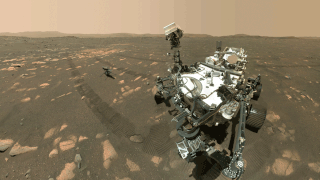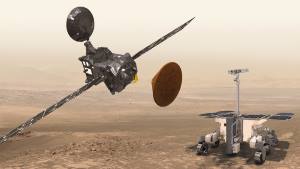Related Research Articles

Mars Express is a space exploration mission being conducted by the European Space Agency (ESA). The Mars Express mission is exploring the planet Mars, and is the first planetary mission attempted by the agency. "Express" originally referred to the speed and efficiency with which the spacecraft was designed and built. However, "Express" also describes the spacecraft's relatively short interplanetary voyage, a result of being launched when the orbits of Earth and Mars brought them closer than they had been in about 60,000 years.

The planet Mars has been explored remotely by spacecraft. Probes sent from Earth, beginning in the late 20th century, have yielded a large increase in knowledge about the Martian system, focused primarily on understanding its geology and habitability potential. Engineering interplanetary journeys is complicated and the exploration of Mars has experienced a high failure rate, especially the early attempts. Roughly sixty percent of all spacecraft destined for Mars failed before completing their missions, with some failing before their observations could begin. Some missions have been met with unexpected success, such as the twin Mars Exploration Rovers, Spirit and Opportunity, which operated for years beyond their specification.

ExoMars is an astrobiology programme of the European Space Agency (ESA).

Planetary protection is a guiding principle in the design of an interplanetary mission, aiming to prevent biological contamination of both the target celestial body and the Earth in the case of sample-return missions. Planetary protection reflects both the unknown nature of the space environment and the desire of the scientific community to preserve the pristine nature of celestial bodies until they can be studied in detail.

A sample-return mission is a spacecraft mission to collect and return samples from an extraterrestrial location to Earth for analysis. Sample-return missions may bring back merely atoms and molecules or a deposit of complex compounds such as loose material and rocks. These samples may be obtained in a number of ways, such as soil and rock excavation or a collector array used for capturing particles of solar wind or cometary debris. Nonetheless, concerns have been raised that the return of such samples to planet Earth may endanger Earth itself.

A Mars sample-return (MSR) mission is a proposed mission to collect rock and dust samples on Mars and return them to Earth. Such a mission would allow more extensive analysis than that allowed by onboard sensors.

The idea of sending humans to Mars has been the subject of aerospace engineering and scientific studies since the late 1940s as part of the broader exploration of Mars. Long-term proposals have included sending settlers and terraforming the planet. Currently, only robotic landers and rovers have been on Mars. The farthest humans have been beyond Earth is the Moon, under the U.S. National Aeronautics and Space Administration (NASA) Apollo program which ended in 1972.

The Mars Exploration Joint Initiative (MEJI) is an agreement signed between United States' space agency, NASA, and Europe's space agency, ESA to join resources and expertise in order to continue the exploration of the planet Mars. The agreement was signed in Washington D.C. in October 2009, between NASA administrator Charles Bolden and ESA director-general Jean-Jacques Dordain.

The Planetary Science Decadal Survey is a serial publication of the United States National Research Council produced for NASA and other United States Government Agencies such as the National Science Foundation. The documents identify key questions facing planetary science and outlines recommendations for space and ground-based exploration ten years into the future. Missions to gather data to answer these big questions are described and prioritized, where appropriate. Similar decadal surveys cover astronomy and astrophysics, earth science, and heliophysics.

Doug McCuistion is the former director of NASA's Mars Exploration Program. He is now the chief operating officer of X-Energy, LLC, a nuclear energy company developing high-temperature gas-cooled reactors located in Rockville, Maryland.
Rosalind Franklin, previously known as the ExoMars rover, is a planned robotic Mars rover, part of the international ExoMars programme led by the European Space Agency and the Russian Roscosmos State Corporation. The mission was scheduled to launch in July 2020, but was postponed to 2022. The Russian invasion of Ukraine has caused an indefinite delay of the programme, as the member states of the ESA voted to suspend the joint mission with Russia; in July 2022, ESA terminated its cooperation on the project with Russia. As of May 2022, the launch of the rover is not expected to occur before 2028 due to the need for a new non-Russian landing platform.

The NASA International Space Apps Challenge is the largest global annual hackathon. This two-day event provides an opportunity for participants to utilize NASA's free and open data and its Space Agency Partners' space-based data to address real-world problems on Earth and in space.
Phootprint is a proposed sample-return mission to the Mars moon Phobos by the European Space Agency (ESA), proposed to be launched in 2024.
The International Lunar Exploration Working Group(ILEWG) is a public forum sponsored by the world's space agencies to support "international cooperation towards a world strategy for the exploration and utilization of the Moon - our natural satellite" (International Lunar Workshop, Beatenberg (CH), June 1994).

The Science Programme of the European Space Agency is a long-term programme of space science and space exploration missions. Managed by the agency's Directorate of Science, The programme funds the development, launch, and operation of missions led by European space agencies and institutions through generational campaigns. Horizon 2000, the programme's first campaign, facilitated the development of eight missions between 1985 and 1995 including four "cornerstone missions" – SOHO and Cluster II, XMM-Newton, Rosetta, and Herschel. Horizon 2000 Plus, the programme's second campaign, facilitated the development of Gaia, LISA Pathfinder, and BepiColombo between 1995 and 2005. The programme's current campaign since 2005, Cosmic Vision, has so far funded the development of ten missions including three flagship missions, JUICE, Athena, and LISA. The programme's upcoming fourth campaign, Voyage 2050, is currently being drafted. Collaboration with agencies and institutions outside of Europe occasionally occur in the Science Programme, including a collaboration with NASA on Cassini–Huygens and the CNSA on SMILE.
HERACLES is a planned robotic transport system to and from the Moon by Europe (ESA), Japan (JAXA) and Canada (CSA) that will feature a lander called the European Large Logistic Lander, a Lunar Ascent Element, and a rover. The lander can be configured for different operations such as up to 1.5 tons of cargo delivery, sample-returns, or prospecting resources found on the Moon.

The International Mars Ice Mapper Mission (I-MIM) is a proposed Mars orbiter being developed by NASA, Japan Aerospace Exploration Agency (JAXA), the Canadian Space Agency (CSA), and the Italian Space Agency (ASI). As the mission concept evolves, there may be opportunities for other space agency and commercial partners to join the mission. The goal of the orbiter is the quantification of extent and volume of water ice in non-polar regions of Mars. The results are intended to support future Mars missions, especially with respect to the search for habitable environments and accessible In situ resource utilization (ISRU) resources. The International-Mars Ice Mapper is an "exploration precursor mission", comparing it to the Lunar Reconnaissance Orbiter (LRO) mission. The mission was envisioned to be launched as early as 2026. However, in March 2022, it was revealed in its fiscal year 2023 budget proposal that the US government would terminate NASA financial support for the Mars Ice Mapper, casting the project's future into uncertainty.

The NASA-ESA Mars Sample Return is a proposed Flagship-class Mars sample return (MSR) mission to collect Martian rock and soil samples in 43 small, cylindrical, pencil-sized, titanium tubes and return them to Earth around 2033.
References
- ↑ "Towards Mars: INTERNATIONAL STRATEGY FOR THE EXPLORATION OF MARS". Web site of James E. Tillman, U. of Washington. Retrieved 6 October 2024.
- ↑ Huntress, W.T. (1994). "Space Science in the 1990's and Beyond". In Huntsville Association of Technical Societies. Bibcode:1994tabessymp.....H.
- ↑ Lambright, W. Henry (2014). Why Mars: NASA and the Politics of Space Exploration (1 ed.). Baltimore: Johns Hopkins University Press. p. 124. ISBN 978-1-4214-1279-5.
- ↑ International Mars Exploration Working Group (1995). "International strategy for the exploration of Mars". Planetary and Space Science. 43 (5): 581–595. Bibcode:1995P&SS...43..581I. doi:10.1016/0032-0633(94)00208-9.
- ↑ Banerdt, B.; Chicarro, A.F.; Coradini, M.; Federico, C.; Greeley, R.; Hechler, M.; Knudsen, J.M.; Leovy, C.; Lognonné, P.; Lowry, L.; McCleese, D.; McKay, C.; Pellinen, R.; Phillips, R.; Scoon, G.E.N.; Spohn, T.; Squyres, S.; Taylor, F.; Wänke, H. (April 1996). INTERMARSNET Phase-A Study Report. ESA Publication D/SCI(96)2. Noordwijk: ESA. Bibcode:1996irop.book.....B.
- ↑ IMEWG activities. Presentations to COSPAR symposium. Hamburg, July 1994. https://doi.org/10.1016/0045-8732(94)90007-8
- ↑ Chicarro, A.; Squyres, S. (July 1994). Battrick, B. (ed.). Together To Mars. An Initiative of the International Mars Exploration Working Group. ESA BR-105. Contributors: Blamont, J., Bourke, R., Carr, M., Coradini, M. and Friedman, L. Noordwijk: ESA. Bibcode:1994ttma.book.....C.
- ↑ "Europe Plays a Major Part in Future Mars Exploration". European Space Agency. 21 November 2000. Retrieved 6 October 2024.
- ↑ An Exobiological Strategy for Mars Exploration. NASA SP-530. NASA. April 1995. Bibcode:1995esme.book.....M.
- ↑ Preliminary Planning for an International Mars Sample Return Mission. Report of the International Mars Architecture for the Return of Samples (iMARS) Working Group (PDF). iMARS Working Group. 1 June 2008.
- ↑ Haltigin, Timothy; et al. (2018). "IMARS Phase 2". Astrobiology. 18 (S1): S1–S131. doi:10.1089/ast.2018.29027.mars. PMC 5926204 . PMID 29683336.
- ↑ "International Mars Exploration Working Group Terms of Reference" (PDF). IMEWG. Retrieved 6 October 2024.